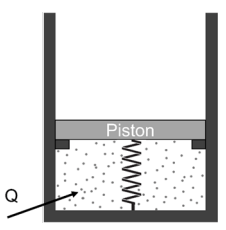A frictionless stainless steel piston-cylinder device contains 20 kg of water at 50 kPa and 50 °C, as shown in Figure 1. A stainless steel spring with a spring constant of 10 kN/m is welded to the bottom of the cylinder, but the other end of the spring is not welded to the piston. The natural length of the spring is 0.5 m. The cross-sectional area of the piston is 0.05 m2. At the initial state, the piston compresses the spring and rests on the stoppers. Heat is then added to the device with a heat source of Q. The final temperature of the system is 150 °C. The local atmospheric pressure is 100 kPa. The weight of the piston is negligible. The volumes of the stoppers and spring are also neglected for simplicity.
- Calculate the volume of the water at the initial state.
- Calculate the pressure of the system when the piston starts moving.
- Determine the nature of the state of the system when the piston just starts leaving the spring.
- Show the P-v diagram and calculate the work done by the system from the initial state to the final state.
- Calculate the amount of heat Q added to the device to reach the final state.

